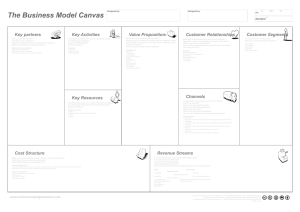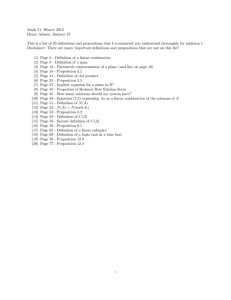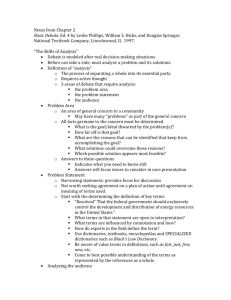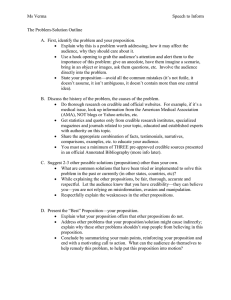Glossary
advertisement
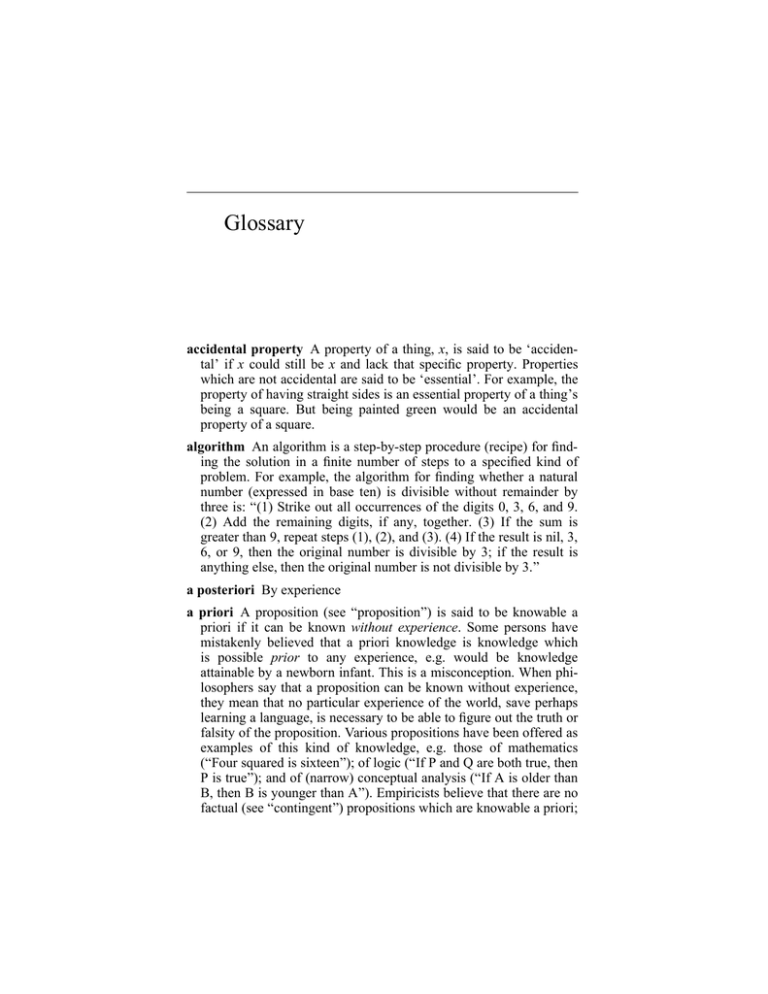
Glossary
accidental property A property of a thing, x, is said to be ‘accidental’ if x could still be x and lack that specific property. Properties
which are not accidental are said to be ‘essential’. For example, the
property of having straight sides is an essential property of a thing’s
being a square. But being painted green would be an accidental
property of a square.
algorithm An algorithm is a step-by-step procedure (recipe) for finding the solution in a finite number of steps to a specified kind of
problem. For example, the algorithm for finding whether a natural
number (expressed in base ten) is divisible without remainder by
three is: “(1) Strike out all occurrences of the digits 0, 3, 6, and 9.
(2) Add the remaining digits, if any, together. (3) If the sum is
greater than 9, repeat steps (1), (2), and (3). (4) If the result is nil, 3,
6, or 9, then the original number is divisible by 3; if the result is
anything else, then the original number is not divisible by 3.”
a posteriori By experience
a priori A proposition (see “proposition”) is said to be knowable a
priori if it can be known without experience. Some persons have
mistakenly believed that a priori knowledge is knowledge which
is possible prior to any experience, e.g. would be knowledge
attainable by a newborn infant. This is a misconception. When philosophers say that a proposition can be known without experience,
they mean that no particular experience of the world, save perhaps
learning a language, is necessary to be able to figure out the truth or
falsity of the proposition. Various propositions have been offered as
examples of this kind of knowledge, e.g. those of mathematics
(“Four squared is sixteen”); of logic (“If P and Q are both true, then
P is true”); and of (narrow) conceptual analysis (“If A is older than
B, then B is younger than A”). Empiricists believe that there are no
factual (see “contingent”) propositions which are knowable a priori;
398
Glossary
Rationalists, in contrast, believe that there are at least some. (See
also the discussion in footnote 8, p. 101.)
begging the question A fallacious manner of arguing in which the
very thing that one is attempting to establish is assumed as a
premise
belief Philosophers use the term “belief ” broadly. Our use includes
religious beliefs, but all other beliefs as well: political beliefs, scientific beliefs, etc. In short, we use this term to encompass anything
believed, from beliefs about the origin of the universe to ones as
mundane as whether the car needs to be washed.
Cartesian Deriving from the philosophy of Ren e´ Descartes
class See “set”.
coextensive 1. Two objects, O ′ and O ″, are coextensive if they
occupy precisely the same region of space.
2. Two events, E ′ and E ″, are coextensive if they occupy the same
interval of time.
3. Two classes (sets) are said to be coextensive if every member of
one is a member of the other and conversely. Thus, for example, the
class which is the largest elected legislative assembly on Earth in
1980 is coextensive with the class which consists of the 1980 membership of the United States Senate and the House of Representatives. Note that the class which consists of the United States
Senate together with the House of Representatives is, by definition,
the United States Congress. But the former class, i.e. the largest
elected legislative assembly on Earth, is not – by definition – the
Congress; it just happens – as a matter of fact – to comprise the
same membership. An alternative way of saying that two classes are
coextensive is to say that they are extensionally equivalent.
confirmation A hypothesis is said to be confirmed if a new prediction derived from that hypothesis is shown to be true. Confirmation
is not, however, verification. To verify a hypothesis is to show it to
be true. Confirmation is a weaker relation than verification. To confirm a hypothesis is to offer in support evidence which falls short of
establishing the truth of that hypothesis. That is, to confirm a
hypothesis is to offer evidence which raises the probability of that
hypothesis being true, but which does not prove it to be true. For
example, someone might try six different chords on a piano and
find them all in tune. Such evidence would confirm the hypothesis
Glossary
399
that all strings on the piano were in tune, but would not verify that
hypothesis. It remains possible that some of the untested strings are
out of tune.
contingent A proposition P is said to be contingent if neither it (i.e.
P) nor its denial (i.e. not-P) is self-contradictory. Contingent
propositions thus are ones which, from a logical point of view,
could be true and could be false (e.g. that the Titanic struck an
iceberg), i.e. ones which could have either truth-value (see p. 28).
Whether a proposition is contingent or not has nothing whatever to
do with anyone’s knowing its truth-value; it is wholly a matter of
whether or not both it and its denial are free of self-contradiction.
Non-contingent propositions are those which are either self-contradictory themselves (e.g. that someone’s brother is an only child)
or whose denials are self-contradictory (e.g. [the necessary truth]
that all squares have four sides). Some philosophers explicate the
distinction between contingency and non-contingency by saying
that a contingent proposition is one which is true in some possible
world(s) and is false in some (other) possible world(s), while a
non-contingent proposition either is true in all possible worlds or is
false in all possible worlds.
“Contingent” used in its technical sense, as it is in this book, does
not mean, as it often does in ordinary English, “conditional upon”,
as when, for example, one might say, “Their attending the picnic
will be contingent upon the weather.” This latter, ordinary, use of
“contingent” is simply not used at all in this book.
counterfactual “Counterfactual” means “contrary-to-(actual)-fact”.
One of the most common devices philosophers use to try to discover persons’ dispositions to use a certain term, x, is to ask questions of the sort, “What would you say if such-and-such were
(counterfactually) to be so-and-so? Would you describe it as being
x?” For many philosophical purposes, “counterfactually” and “in
another (i.e. non-actual) possible world” may be used interchangeably. (See section 6.4, pp. 108ff.)
descriptive definition A descriptive definition is one which reports
the standard usage of a term. It may be contrasted with normative
and with stipulative definitions. A normative definition is one which
attempts to refine a usage, as we see, for example, in some dictionaries warning readers not to use “infer” and “imply” interchangeably. See also “stipulative definition”.
400
Glossary
empirical 1. “Empirical” is most often used as a modifier of “knowledge”. When so used it describes the mode by which that knowledge is obtainable. Some authors use the term “empirical” as equivalent to “a posteriori”, i.e. as equivalent to “by experience”. In this
book, however, I adopt the stricter (narrower) meaning prescribed
by Immanuel Kant in which “empirical” means not “by experience”
but “only by experience” (see [34], 149-56). When I write that
something, P, is knowable empirically, I mean that P cannot be
known (by human beings) in any way other than by experience.
Whatever is humanly knowable, but in a way other than by experience, is knowable a priori. (See definitions of “a priori” and “a posteriori”.)
2. Occasionally “empirical” is also used as a modifier of “concept”.
An empirical concept is one whose referent is observable or detectable through experience. Weight is thus an empirical concept; soul
and substance are often regarded as nonempirical concepts.
epistemology One of the principal branches of philosophy, epistemology is the theory of knowledge. Its subject matter includes the
role of sense perception in the acquisition of knowledge, the possibility of attaining objective knowledge, the psychological aspects
of knowledge, and – on some accounts – the sociological aspects of
knowledge. (The adjectival forms are “epistemic” and “epistemological”.)
eschatological Pertaining to the end of the world, life after death, etc.
exobiology The term “exobiology” was coined (c. 1960) ([21], 355)
by the geneticist, Joshua Lederberg ([69]). It refers to the study of
(or, for the present time at least, the search for) life beyond the
Earth’s atmosphere, in effect on other planets. Whereas the program
S E T I is the search for intelligent extraterrestrial life, the scope of
exobiology is wider: it is the search for alien life itself, intelligent or
not.
formal “Formal” pertains to structure; its contrast is content. For
example, the two sentences “Sally sees Richard” and “New York is
larger than Boston”, while having different content, share some of
the same structure, i.e. are formally alike to a degree, in that both
consist of a relational term flanked fore and aft by proper names. In
section 8.8, I write about certain formal properties shared by spatial
and temporal relations. For example, the spatial relation of being
north of is, to a certain degree, formally equivalent to the temporal
Glossary
401
relation of being earlier than. Both are so-called ‘ordering relations’: locations in space (along a line of longitude) may be arranged in order according to the relation is north of; similarly,
events (subject to certain constraints within special relativity theory) may be ordered according to the relation is earlier than. (In
logical terms, both these relations bear the formal, or structural,
properties of transitivity, asymmetry, and irreflexivity. See, e.g.,
[34], 339-42.)
half-truth There are only two truth-values (see p. 28): true and false.
There is nothing ‘intermediate’ between truth and falsity. That is,
there is no ‘third’, or ‘middle’ truth-value. (This latter claim has
since ancient times been known as the law of the excluded middle.)
Thus no single proposition can be either half-true or half-false.
However, a set of two or more propositions may contain some
members which are true and others which are false. Although any
set of propositions which contains even a single false proposition is,
taken as a whole, false, it is sometimes convenient to designate sets
which contain some false propositions and some true propositions
as being a ‘half-truth’. A half-truth is thus a ‘mixed’ set of propositions: some of its members are true, but only some; the others are
false.
idealism Idealism is the theory that the only things that exist are
minds and their contents, e.g. pains, beliefs, desires, sensations of
sounds, afterimages. Although “idealistic” is often used in ordinary
speech to describe persons who have ‘ideals’, i.e. ambitions to better themselves or the world at large, this is not the sense of “idealism” being used in this book. Here, “idealism” is the name of a
metaphysical thesis which contrasts, in the first instance, with
materialism. (See also “materialism”.)
individual (noun) In ordinary speech, “individual” usually means a
person. But in philosophical terminology, “individual” is given a
wider meaning. As often used by philosophers, “individual” means
not just persons, but any particular thing whatever: individual
noises, cars, violins, pains, memories, molecules, stars, etc. An individual is, then, anything which is located in space and time.
Another term which is used virtually interchangeably with “individual” is “particular”. (Note: some philosophers will use “individual”
in an even broader sense. They use “individual” to refer to anything
whatsoever which may be talked about as the subject of discourse.
402
Glossary
Thus they will include the number two, the number three, etc. in the
class of individuals even though they may be disinclined to believe
that such ‘entities’ are located in space and time. The mere fact that
one can attribute properties to numbers, e.g. “The number two is
even”, suffices – on this latter account – to win for numbers the
status of being individuals.)
materialism Materialism is the theory that the only things that exist
are material (physical) things: subatomic particles through to human
bodies and their brains, and on through to stars, galaxies, and galactic clusters. But beyond these things and their distinctive properties,
there are no other sorts of things, e.g. minds or supernatural beings,
in the world. This technical sense must be distinguished from the
more familiar, ordinary sense in which “materialism” is used to
describe the greed of persons who are overly acquisitive of material
possessions. (See also “idealism”.)
methodology The body of techniques, rules, and procedures adopted
for the pursuit of some discipline, e.g. science. Methodological
assumptions are sometimes adopted, not so much because they are
themselves believed to be true, but because their adoption is believed to offer a profitable manner of pursuing truth. For example,
some psychologists will adopt behaviorism as a methodological
principle, not so much because they believe that all mental acts can
in some sense be ‘reduced to’ overt behavior, but because they
believe that studying behavior provides the best – and in some
instances, the only – access scientists have to the mental states of
other persons.
modality 1. In philosophy, “modality” refers to that family of properties which includes possibility, impossibility, contingency, and
necessity. To specify, then, the modal status of a proposition is to
say something about its possibility, impossibility, contingency, or
necessity. One particularly fashionable way to explicate modal concepts in contemporary philosophy is through the idiom of possible
worlds. A proposition is said to be (logically) possible, for example,
if it is true in at least one possible world; a proposition is said to be
( logically) impossible if it is true in no possible worlds; etc. Modal
status is often contrasted with epistemic status, the latter having to
do with whether a proposition is knowable or unknowable, known
or unknown. (Modal and epistemic status can link in sixteen different combinations. See [34], esp. 156-75.)
Glossary
403
2. In psychology, “modality” refers to any of several different kinds
of sensory abilities (or senses), e.g. seeing, hearing, smelling. Sight
comprises one sensory modality (or mode); hearing, another; smelling, still another; etc.
necessary condition “x is a necessary condition for y” means “if x
did not exist ( / did not occur / was false), then y would not exist
( / would not occur / would be false)”. For example, being more than
twelve years old is a necessary condition for being twenty years old,
inasmuch as a thing / person which was not more than twelve years
old would not be twenty years old. Pulling a face card from a deck
of cards is a necessary condition for pulling a Queen, but it is not a
sufficient condition: the face card pulled may be a Jack. (See also
“sufficient condition”.) If x is a necessary condition for y, then y –
in turn – is a sufficient condition for x.
necessary truth A proposition (see below) is a necessary truth if its
denial is self-contradictory. Synonyms for “necessary truth” include
“logical truth” and “non-contingent truth”. Using the possibleworlds idiom, a necessary truth may be explicated as a proposition
which is true in all logically possible worlds, i.e. true under any
logically possible circumstances. Necessary truths include such
propositions as “2 + 2 = 4” and “All red things are colored.”
ontology 1. The fundamental categories of what sorts or kinds of
things there are in the universe. At one level of analysis, tables and
chairs might be considered to be distinct kinds of things; but for the
purposes of ontology, tables and chairs are (usually regarded as
being) the same sort of ‘thing’, namely physical (or spatiotemporal)
entities. Other ‘fundamental’ sorts of things which have been proposed by various philosophers at one time or another have been:
sets (or classes), propositions, facts, states of affairs, universals,
numbers, causal connections, forces, substances, souls, minds, spiritual beings, ethical values, purposes, etc.
2. The branch of metaphysics concerned with the fundamental
categories of things
particular (noun) See “individual”.
particular (adj.) When used as an adjective, “particular” typically
modifies “proposition” or “statement”. A particular proposition is
one of the form “Some S is P” or “There are Ss (which are Ps).”
Another name for “particular proposition” is “existential proposi-
404
Glossary
tion”. Particular propositions should not be confused with singular
propositions. Particular propositions are general propositions: they
refer, not to specific individuals, but to classes of individuals.
However, singular propositions, e.g. “Brian Mulroney is prime minister”, do refer to specific individuals. Just to make life complicated: singular propositions refer to specific particulars; particular
propositions do not.
phenomenology A description of the formal structure of the objects
of awareness, i.e. a description of the appearance of things, disregarding any account of their origin, explanation, causes, etc.
(There is, in addition, a philosophical school called ‘Phenomenology’, founded by Brentano and extended by Husserl. This latter –
different – sense of “phenomenology” is not invoked in this book.)
physical impossibility A situation is physically impossible if its
description is inconsistent with physical laws (i.e. with the laws of
Nature). For example, it is thought that it is a physical law ( law of
Nature) that no material object can be accelerated past the speed of
light (300,000 km / sec). If so, then it is physically impossible for
there to be some material object which is accelerated to, let us say,
375,000 km / sec. But note that although this latter situation is said
to be physically impossible, its description is not logically selfinconsistent, and hence is not logically impossible.
posit (noun) A hypothesis or assumption
posit (verb) To put forward a posit, i.e. to assume a hypothesis
predicate (verb) To attribute a quality or relation to
proposition Some philosophers use the term “statement” as a
synonym for “proposition”. Propositions are the sorts of things
which are true or false; they are the sorts of things which may be
believed, disbelieved, known, doubted, etc. In English, propositions
often are expressed by so-called ‘that-phrases’, e.g. “She knew that
the train would be late” and “He theorized that the solution contained copper sul fate”. (For a discussion of several different theories about the metaphysical nature of propositions, see [34], 65-127,
esp. 65-86.)
question-begging See “begging the question”.
reciprocal (math.) The reciprocal of a number is its multiplicative inverse, i.e. the number which when multiplied by the original num-
Glossary
405
ber yields 1 as the product. Thus, the reciprocal of 3/4 is 4/ 3, and of
–2 is –1/ 2.
retrodiction Retrodicting is the analog of forecasting an event, but
directed oppositely in time, i.e. to the past rather than the future.
Just as one might forecast, from a knowledge of physical laws
along with specific data about the current position and speed of a
comet, where it will be ten years from now, one might retrodict
where it was ten years ago.
semantics Semantics is the branch of the theory of signs dealing with
meaning, e.g. with how descriptive terms (or better, their users)
refer to items and features in the world.
set A set is any class or collection of things. The set (class) may be
‘natural’, e.g. the set of mammals, or it may be completely arbitrary, e.g. the set consisting of Napoleon, the number two, and Vancouver Island. Sets, on most accounts, are regarded as abstract entities and are not to be identified with their members. E.g. the set
which consists of my daughter’s piano is not itself a piano (nor is it,
for that matter, even a physical [material] object). Sets are standardly denoted by braces, e.g. “{Napoleon, 2, Vancouver Island}”.
A set A is said to be a subset of a set B if every member of A is also
a member of B. A set A is said to be a proper subset of a set B if A
is a subset of B, but not conversely. E.g. the set of women is a
proper subset of the set of human beings. Although the terms “subset” and “proper subset” are not, strictly speaking, equivalent, many
authors write the former for the latter.
A set A is said to be a superset of a set B if every member of B is
also a member of A. A set A is said to be a proper superset of a set
B if A is a superset of B, but not conversely. E.g. the set of human
beings is a proper superset of the set of women. Again, as with
“proper subset”, many authors omit “proper” when writing of
proper supersets.
An ordered set (denoted by angle brackets) is one in which both its
membership and the order of the members determine the set. The
(non-ordered) set A, {2, 5, 8}, is identical to the set B, {5, 8, 2}: A
and B have the same membership. But this set also gives rise to six
nonidentical ordered sets: ⟨2, 5, 8⟩, ⟨2, 8, 5⟩, ⟨5, 2, 8⟩, ⟨5, 8, 2⟩,
⟨8, 2, 5⟩, and ⟨8, 5, 2⟩.
406
Glossary
An ordered pair is an ordered set having two members.
stipulative definition A stipulative definition is one which lays down
a specific, usually specialized and technical, usage for a term.
Examples may be found in the definition of “contingent” above and
“world” below. See also “descriptive definition”.
sufficient condition “x is a sufficient condition for y” means “if x
exists ( / occurs / is true), then y exists ( / occurs / is true)”. For example, being twenty years old is a sufficient condition for being
more than twelve years old, inasmuch as any thing / person which is
twenty years old is thereby guaranteed to be a thing which is more
than twelve years old. Pulling a Queen from a deck of playing cards
is a sufficient condition for pulling a face card, but it is not a necessary condition: one could pull a face card which was not a Queen,
i.e. a King or a Jack. (See also “necessary condition”.) If x is a
sufficient condition for y, then y – in turn – is a necessary condition
for x.
sui generis In a class by itself
topology Geometry has two branches: metrical geometry and topology. Metrical geometry concerns measurement and size – such matters as, for example, proportionality; relative sizes of angles;
lengths of peripheries; angles formed by the intersection of
diagonals; projections of three-dimensional objects onto twodimensional surfaces; and perspective. Topology, in contrast, is
concerned with those aspects of geometry which are independent of
the sizes of the figures, indeed which would still obtain even if the
figure were to be ‘stretched’ or ‘distorted’ (short of ‘tearing’ it) –
such matters as, for example, the existence of paths connecting two
or more regions; the equivalence of knots; and the number of colors
required (in principle) to color any arbitrary map so that no two
adjacent regions have the same color. From a metrical point of
view, a sphere, an oval, and an ellipse are all different figures; from
a topological point of view, they are identical. Similarly, from a
topological point of view, these three figures share the same
topological dimensions: they are two-dimensional whatever their
sizes or however they are stretched.
underdetermined A hypothesis or theory is said to be underdetermined by the evidence which supports it if that evidence does not
logically guarantee the truth of that hypothesis or theory. If some
Glossary
407
evidence underdetermines a hypothesis, then that same evidence
also underdetermines (some) competing theories. Thus, for example, using the (necessarily inconclusive) evidence produced by
the Warren Commission, many writers have proposed several different theories of John F. Kennedy’s assassination: e.g. that Oswald
acted alone, that Oswald was not the assassin, that there was a
second shooter, that organized crime planned the operation, and that
foreign nationals planned the operation.
universal (adj.) The adjectival form of “universal” means “for all of
the universe, i.e. throughout all of space and time.” “Universal” is
not limited just to the planet Earth. (See “world”.) “Universal” does
not mean “necessary”. Something can be universally true without
being necessarily true, e.g. that the speed of light is greater than
290,000 km / sec.
universal (noun) According to the theory of Realism, the properties
of particulars (see above) are posited to be (abstract) entities ‘subsisting’ outside of space and time. Such entities are usually called
“universals”. In this theory, the class of universals includes greenness, triangularity, solubility, hardness, etc. As well, especially
since the early twentieth century, it has become usual for Realism to
include among universals the relations obtaining between particulars, e.g. being to the left of or being older than. Needless to say,
the ontological status of universals, i.e. the ‘nature’ of their existence, has been a subject of intense controversy in metaphysics since
Plato first introduced the topic. For more on universals, see chapter
9, esp. sect. 9.3.
world Throughout this book, when I use the term “world”, I mean
the entire universe, both what is known of it and what is unknown; I
also include all of the world’s history, its present, and its future in
this all-encompassing term. I never use “world” to mean (just) the
planet Earth, or – for that matter – any other planet.
408
Glossary
This page deliberately left blank.



